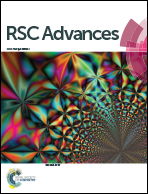Facile synthesis of novel hydrophilic and carboxyl-amine functionalized superparamagnetic iron oxide nanoparticles for biomedical applications†
Abstract
In this work, we aim to synthesize water soluble and surface functionalized superparamagnetic iron oxide nanoparticles (SPIONs) using novel surfactants such as terephthalic acid (TA), 2-aminoterephthalic acid (ATA), trimesic acid (TMA) and pyromellitic acid (PMA) through one-step facile chemical co-precipitation and thermal decomposition methods. The as-synthesized SPIONs are characterized using X-ray diffraction (XRD), transmission electron microscopy (TEM), dynamic light scattering (DLS) measurements, Fourier transform infrared spectroscopy (FTIR), thermogravimetric analysis (TGA) and vibrating sample magnetometer (VSM). The as-synthesized SPIONs showed very good water solubility and a high magnetization value (Ms = 55–73 emu g−1). Furthermore, the as-synthesized ATA-coated SPIONs are conjugated with a fluorophore (Alexa Fluor 488) to demonstrate their ability for further chemical/biological conjugation without any additional surface modifications. Moreover, above 90% cell viability in MCF-7 cancer cells has been observed, thus confirming good cytocompatibility of the SPIONs. Therefore, these hydrophilic and carboxyl-amine functionalized SPIONs are very promising candidates to be used for biomedical applications.



 Please wait while we load your content...
Please wait while we load your content...